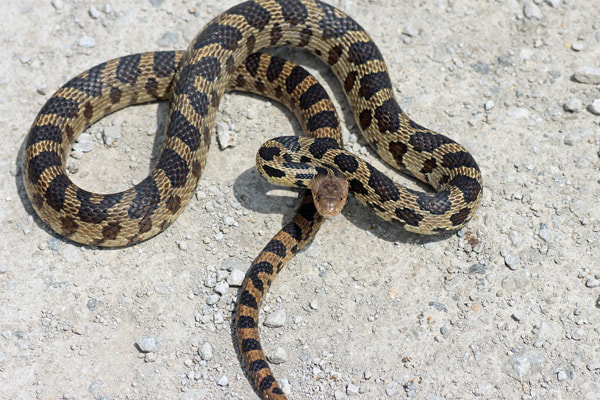WESTERN FOX SNAKE
Pantherophis ramspotti
Constrictor- Nonvenomous
This snake is a marsh-dwelling member of the rat snake family, the Western Fox Snake is rare in Missouri only being found in the upper Northwest and Northeast counties of the state. It is a large snake with distinct brown blotches. The dorsal is yellowish, greenish brown, or tan, with an average of 37 large brown blotches on the back and smaller ones on the sides. The head of the fox snake may show some orange or brownish color. The belly is normally yellow, marked with a distinct black checkered pattern.
Adults range from 3-4.5 feet long.
Western fox snakes are found in grasslands, prairies, dune areas, farm fields, pastures, and woodlots. They are typically found close to water. These snakes can be found basking near the edge of marshes or in grass clearings.
Western fox snakes eat small mammals and occasional birds. They also will eat voles, mice, eggs, fledgling birds, and newborn rabbits.
Western fox snakes have good climbing skills but are usually seen on the ground in fields or marshes. When annoyed, irritated, or scared these fox snakes will vibrate their tail.
A 2011 paper by Crother, White, Savage, Eckstut, Graham, Gardner proposed that the Mississippi River be established as the species boundary between two species of fox snakes, and that those found to its east be considered P. vulpinus and those found to its west be given the new name P. ramspotti to avoid confusion.
This snake is a marsh-dwelling member of the rat snake family, the Western Fox Snake is rare in Missouri only being found in the upper Northwest and Northeast counties of the state. It is a large snake with distinct brown blotches. The dorsal is yellowish, greenish brown, or tan, with an average of 37 large brown blotches on the back and smaller ones on the sides. The head of the fox snake may show some orange or brownish color. The belly is normally yellow, marked with a distinct black checkered pattern.
Adults range from 3-4.5 feet long.
Western fox snakes are found in grasslands, prairies, dune areas, farm fields, pastures, and woodlots. They are typically found close to water. These snakes can be found basking near the edge of marshes or in grass clearings.
Western fox snakes eat small mammals and occasional birds. They also will eat voles, mice, eggs, fledgling birds, and newborn rabbits.
Western fox snakes have good climbing skills but are usually seen on the ground in fields or marshes. When annoyed, irritated, or scared these fox snakes will vibrate their tail.
A 2011 paper by Crother, White, Savage, Eckstut, Graham, Gardner proposed that the Mississippi River be established as the species boundary between two species of fox snakes, and that those found to its east be considered P. vulpinus and those found to its west be given the new name P. ramspotti to avoid confusion.

